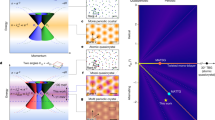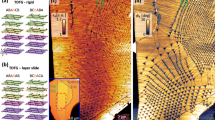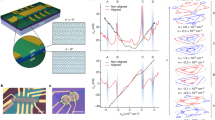Abstract
Heterostructures can be assembled from atomically thin materials by combining a wide range of available van der Waals crystals, providing exciting possibilities for designer electronics1. In many cases, beyond simply realizing new material combinations, interlayer interactions lead to emergent electronic properties that are fundamentally distinct from those of the constituent layers2. A critical parameter in these structures is the interlayer coupling strength, but this is often not easy to determine and is typically considered to be a fixed property of the system. Here we demonstrate that we can controllably tune the interlayer separation in van der Waals heterostructures using hydrostatic pressure, providing a dynamic way to modify their electronic properties. In devices in which graphene is encapsulated in boron nitride and aligned with one of the encapsulating layers, we observe that increasing pressure produces a superlinear increase in the moiré-superlattice-induced bandgap—nearly doubling within the studied range—together with an increase in the capacitive gate coupling to the active channel by as much as 25 per cent. Comparison to theoretical modelling highlights the role of atomic-scale structural deformations and how this can be altered with pressure. Our results demonstrate that combining hydrostatic pressure with controlled rotational order provides opportunities for dynamic band-structure engineering in van der Waals heterostructures.
This is a preview of subscription content, access via your institution
Access options
Access Nature and 54 other Nature Portfolio journals
Get Nature+, our best-value online-access subscription
$29.99 / 30 days
cancel any time
Subscribe to this journal
Receive 51 print issues and online access
$199.00 per year
only $3.90 per issue
Buy this article
- Purchase on SpringerLink
- Instant access to full article PDF
Prices may be subject to local taxes which are calculated during checkout




Similar content being viewed by others
References
Geim, A. K. & Grigorieva, I. V. Van der Waals heterostructures. Nature 499, 419–425 (2013).
Novoselov, K. S., Mishchenko, A., Carvalho, A. & Castro Neto, A. H. 2D materials and van der Waals heterostructures. Science 353, aac9439 (2016).
Wang, L. et al. One-dimensional electrical contact to a two-dimensional material. Science 342, 614–617 (2013).
Mishchenko, A. et al. Twist-controlled resonant tunnelling in graphene/boron nitride/graphene heterostructures. Nat. Nanotech. 9, 808–813 (2014).
Yu, H., Wang, Y., Tong, Q., Xu, X. & Yao, W. Anomalous light cones and valley optical selection rules of interlayer excitons in twisted heterobilayers. Phys. Rev. Lett. 115, 187002 (2015).
Yankowitz, M. et al. Emergence of superlattice Dirac points in graphene on hexagonal boron nitride. Nat. Phys. 8, 382–386 (2012).
Ponomarenko, L. A. et al. Cloning of Dirac fermions in graphene superlattices. Nature 497, 594–597 (2013).
Dean, C. R. et al. Hofstadter’s butterfly and the fractal quantum Hall effect in moiré superlattices. Nature 497, 598–602 (2013).
Hunt, B. et al. Massive Dirac fermions and Hofstadter butterfly in a van der Waals heterostructure. Science 340, 1427–1430 (2013).
Woods, C. R. et al. Commensurate–incommensurate transition in graphene on hexagonal boron nitride. Nat. Phys. 10, 451–456 (2014).
Gorbachev, R. V. et al. Detecting topological currents in graphene superlattices. Science 346, 448–451 (2014).
Wang, L. et al. Evidence for a fractional fractal quantum Hall effect in graphene superlattices. Science 350, 1231–1234 (2015).
Wang, E. et al. Gaps induced by inversion symmetry breaking and second-generation Dirac cones in graphene/hexagonal boron nitride. Nat. Phys. 12, 1111–1115 (2016).
Spanton, E. M. et al. Observation of fractional Chern insulators in a van der Waals heterostructure. Science 360, 62–66 (2018).
Dean, C. R. et al. Boron nitride substrates for high-quality graphene electronics. Nat. Nanotech. 5, 722–726 (2010).
Park, C.-H., Yang, L., Son, Y.-W., Cohen, M. L. & Louie, S. G. New generation of massless Dirac fermions in graphene under external periodic potentials. Phys. Rev. Lett. 101, 126804 (2008).
Chen, G. et al. Emergence of tertiary Dirac points in graphene moiré superlattices. Nano Lett. 17, 3576–3581 (2017).
Kim, K. et al. Van der Waals heterostructures with high accuracy rotational alignment. Nano Lett. 16, 1989–1995 (2016).
Woods, C. R. et al. Macroscopic self-reorientation of interacting two-dimensional crystals. Nat. Commun. 7, 10800 (2016).
Chari, T., Ribeiro-Palau, R., Dean, C. R. & Shepard, K. Resistivity of rotated graphite–graphene contacts. Nano Lett. 16, 4477–4482 (2016).
Koren, E. et al. Coherent commensurate electronic states at the interface between misoriented graphene layers. Nat. Nanotech. 11, 752–757 (2016).
Solozhenko, V. L., Will, G. & Elf, F. Isothermal compression of hexagonal grpahite-like boron nitride up to 12 GPa. Solid State Commun. 96, 1–3 (1995).
Chen, Y. et al. Pressurizing field-effect transistors of few-layer MoS2 in a diamond anvil cell. Nano Lett. 17, 194–199 (2017).
Chen, Z.-G. et al. Observation of an intrinsic bandgap and Landau level renormalization in graphene/boron-nitride heterostructures. Nat. Commun. 5, 4461 (2014).
Song, J. C. W., Shytov, A. V. & Levitov, L. S. Electron interactions and gap opening in graphene superlattices. Phys. Rev. Lett. 111, 266801 (2013).
Bokdam, M., Amlaki, T., Brocks, G. & Kelly, P. J. Band gaps in incommensurable graphene on hexagonal boron nitride. Phys. Rev. B 89, 201404(R) (2014).
Moon, P. & Koshino, M. Electronic properties of graphene/hexagonal-boron-nitride moiré superlattice. Phys. Rev. B 90, 155406 (2014).
Wallbank, J. R., Mucha-Kruczynski, M., Chen, X. & Fal’ko, V. I. Moiré superlattice effects in graphene/boron-nitride van der Waals heterostructures. Ann. Phys. 527, 359–376 (2015).
Jung, J., DaSilva, A. M., MacDonald, A. H. & Adam, S. Origin of band gaps in graphene on hexagonal boron nitride. Nat. Commun. 6, 6308 (2015).
San-Jose, P., Gutiérrez-Rubio, A., Sturla, M. & Guinea, F. Spontaneous strains and gap in graphene on boron nitride. Phys. Rev. B 90, 075428 (2014).
Slotman, G. et al. Effect of structural relaxation on the electronic structure of graphene on hexagonal boron nitride. Phys. Rev. Lett. 115, 186801 (2015).
Jung, J. et al. Moiré band model and band gaps of graphene on hexagonal boron nitride. Phys. Rev. B 96, 085442 (2017).
Yankowitz, M., Watanabe, K., Taniguchi, T., San-Jose, P. & LeRoy, B. J. Pressure-induced commensurate stacking of graphene on boron nitride. Nat. Commun. 7, 13168 (2016).
Murata, K., Yoshina, H., Yadav, H. O., Honda, Y. & Shirakawa, N. Pt resistor thermometry and pressure calibration in a clamped pressure cell with the medium, daphne 7373. Rev. Sci. Instrum. 68, 2490–2493 (1997).
Murata, K. et al. Pressure transmitting medium Daphne 7474 solidifying at 3.7 gpa at room temperature. Rev. Sci. Instrum. 79, 085101 (2008).
Piermarini, G. J., Block, S. & Barnett, J. D. Hydrostatic limits in liquids and solids to 100 kbar. J. Appl. Phys. 44, 5377–5382 (1973).
Ragan, D. D., Gustavsen, R. & Schiferl, D. Calibration of the ruby R 1 and R 2 fluorescence shifts as a function of temperature from 0 to 600 K. J. Appl. Phys. 72, 5539–5544 (1992).
Blakslee, O. L., Proctor, D. G., Seldin, E. J., Spence, G. B. & Weng, T. Elastic constants of compression-annealed pyrolytic grpahite. J. Appl. Phys. 41, 3373–3382 (1970).
Weis, J. & von Klitzing, K. Metrology and microscopic picture of the integer quantum Hall effect. Philos. Trans. R. Soc. Lond. A 369, 3954–3974 (2011).
Maher, P. et al. Tunable fractional quantum hall phases in bilayer graphene. Science 345, 61–64 (2014).
Bistritzer, R. & MacDonald, A. H. Moiré bands in twisted double-layer graphene. Proc. Natl Acad. Sci. USA 108, 12233–12237 (2011).
Acknowledgements
We thank P. San-Jose, J. Song, A. Shytov, L. Levitov, J. Wallbank and P. Moon for theoretical discussions. This work was supported by the National Science Foundation (NSF) (DMR-1462383). C.R.D. acknowledges partial support from the David and Lucille Packard foundation. Development of the device concept and fabrication process was partially supported by the NSF MRSEC program through Columbia in the Center for Precision Assembly of Superstratic and Superatomic Solids (DMR-1420634). We acknowledge S. Tozer for use of his 16 T PPMS which is partially supported as part of the Center for Actinide Science and Technology (CAST), an Energy Frontier Research Center (EFRC) funded by the Department of Energy, Office of Science, Basic Energy Sciences under award no. DE-SC0016568. A portion of this work was performed at the National High Magnetic Field Laboratory, which is supported by NSF Cooperative Agreement no. DMR-1157490, the State of Florida and the US Department of Energy and additionally provided support for pressure cell development through User Collaboration Grant Program (UCGP) funding. J.J. and N.L. were supported by the Korean NRF through grant NRF-2016R1A2B4010105 and Korean Research Fellowship grant NRF-2016H1D3A1023826, and B.L.C. was supported by grant NRF-2017R1D1A1B03035932. E.L. and S.A. are supported by the National Research Foundation of Singapore under its Fellowship program (NRF-NRFF2012-01) and the Singapore Ministry of Education AcRF Tier 2 (MOE2017-T2-2-140). K.W. and T.T. acknowledge support from the Elemental Strategy Initiative conducted by the MEXT, Japan, and JSPS KAKENHI grant no. JP15K21722.
Author information
Authors and Affiliations
Contributions
M.Y. and C.R.D. conceived the experiment. M.Y. fabricated the samples and analysed the data. M.Y. and D.G. performed the experiments. J.J., E.L. and S.A. developed the theory. N.L. and B.L.C. calculated the ab initio potentials. K.W. and T.T. grew the hBN crystals. C.R.D. advised on the experiments. All authors participated in writing the paper.
Corresponding author
Ethics declarations
Competing interests
The authors declare no competing interests.
Additional information
Publisher’s note: Springer Nature remains neutral with regard to jurisdictional claims in published maps and institutional affiliations.
Extended data figures and tables
Extended Data Fig. 1 Pictures of the set-up for pressure experiments.
a, Graphene (outlined in white dashed line) is encapsulated between BN and placed on a graphite back gate. b, The device is shaped into a Hall bar and contacted for electrical measurements. c, The Si wafer is diced to approximate dimensions of 2 mm × 2 mm. d, A new pressure cell stage. e, The stage is threaded with wires which are epoxied in place. f, The sample is glued to the top of the stage. g, Wires are connected to the device electrodes by hand using silver paste. h, A Teflon cup is filled with oil and fitted over the sample and onto the stage. i, The sample is placed into a pressure cell. j, Pressure is loaded using a hydraulic press. k, The loaded pressure cell is attached to a probe for low-temperature magnetotransport measurements. See Methods for complete experimental details. The scale bars for a and b are 25 μm, and the scale bar for c is 2 mm.
Extended Data Fig. 2 Resistivity of device P3 at B = 0 T and T = 2 K.
For the application of high pressure in this device, we observe virtually no change in the device resistivity for hole carriers, and a decrease in the resistivity for electron carriers.
Extended Data Fig. 3 Arrhenius plot for the SDP in device P1.
The gap exhibits virtually no dependence on pressure.
Extended Data Fig. 4 Bandgaps as a function of pressure for all devices studied.
a, Devices with square markers exhibit thermally activated behaviour over roughly an order of magnitude change in resistance. Devices with triangle markers exhibit thermally activated behaviour over a smaller range. The numbered labels represent the order in which the gaps were acquired. The gap magnitude depends only on the pressure the device is under at the time of measurement, and not on the history of the pressure that has been previously applied. Error bars in the gap fitting arising from the uncertainty identifying the thermally activated regime have been omitted for clarity, but are all less than 2.5 meV. b, Gap dependence in a second aligned device (P6), with misalignment of about 0.1°. This device also exhibits a growing Δp and constant Δs, but is much more disordered than device P1. Inset: Arrhenius plots for the PDP (left) and SDP (right) at 0 GPa and 1 GPa.
Extended Data Fig. 5 Conductivity of the PDP over the full temperature range at various pressures for all devices studied.
a, Device P1 is the aligned device discussed in the main text. Inset, conductivity of the SDP. b, Device P6 is a second aligned device, but is more highly disordered and therefore less resistive at low temperature. Inset, conductivity of the SDP. c–f, The remaining devices do not exhibit SDPs, and therefore the alignment to the BN layers is unknown. However, the devices in c and d still exhibit thermally activated behaviour over roughly an order of magnitude change in resistance, suggesting they are nearly aligned to a BN. The devices in e and f have a much smaller thermally activated regime. Pressure tends to have a smaller effect on the PDP conductivity for devices that are less resistive at 0 GPa. The inset in f shows the high-temperature response, demonstrating the weak effect of pressure in the thermally activated regime for the least resistive device. In a–f, although the PDP generally grows more insulating with higher pressure at low temperatures, this is not universally true, suggesting that the details of the low-temperature resistance depends more critically on the exact nature of disorder in the device. Devices are ordered by decreasing gap size as measured in the thermally activated regime.
Extended Data Fig. 6 Disorder and the quantum Hall effect.
a, Device disorder δn is measured as the n necessary to dope between the maximum and minimum Rxy, averaged over B = 0.25 T to 0.75 T. b, Density fluctuations as a function of pressure across different devices. The error bars denote the uncertainty in picking the peak positions of Rxy. c, ρxx (solid lines, left axis) and σxy (dotted lines, right axis) of device P1 at B = 12.5 T. Symmetry-broken integer quantum Hall states become much more clearly developed with pressure, and fractional quantum Hall states begin to emerge as well. Both are offset for clarity. d, ρxx of device P2 at B = 9 T, similarly showing an improvement in the quantum Hall response. Surprisingly, the improvement persists even after the pressure is released back to vacuum and the device is cleaned in solvents (green curve). Curves are vertically offset for clarity.
Extended Data Fig. 7 Hofstadter butterfly as a function of pressure in device P1.
Magnetotransport data acquired at T = 2 K and a pressure of: a, 0 GPa; b, 2.3 GPa.
Supplementary Information
Supplementary Information
This file contains Supplementary Notes S1-S3, includes Supplementary Figures 1-5 and Supplementary Tables 1-2
Rights and permissions
About this article
Cite this article
Yankowitz, M., Jung, J., Laksono, E. et al. Dynamic band-structure tuning of graphene moiré superlattices with pressure. Nature 557, 404–408 (2018). https://doi.org/10.1038/s41586-018-0107-1
Received:
Accepted:
Published:
Issue Date:
DOI: https://doi.org/10.1038/s41586-018-0107-1



